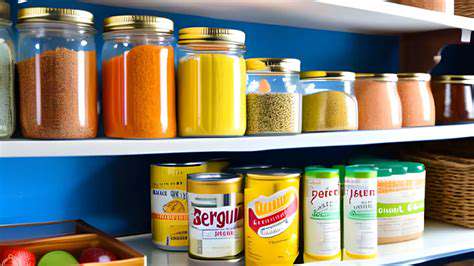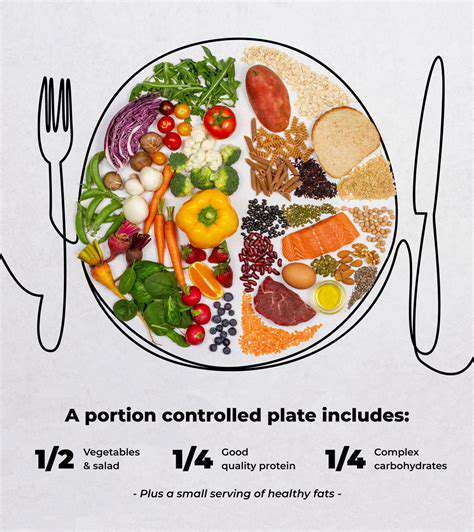Healthy Eating on a Budget: Smart Shopping Tips
Planning Your Trip
Before you even step foot inside the grocery store, take some time to plan your meals for the week. This pre-planning is crucial for avoiding impulse buys and ensuring you're purchasing ingredients that fit into your planned meals. A well-structured meal plan helps you stay organized, reduces food waste, and prevents you from overspending on unnecessary items.
Make a detailed shopping list based on your meal plan. Include specific quantities for each ingredient, noting any dietary restrictions or preferences. This meticulous approach ensures you only buy what you need, preventing excess food purchases and storage challenges, leading to a healthier and more budget-conscious approach to grocery shopping.
Understanding Your Budget
Before heading to the store, it's essential to understand your grocery budget. Knowing your financial limitations will help you make informed decisions while shopping. Calculate how much you can realistically spend on groceries each week, and stick to this limit as closely as possible. Avoid getting caught up in the allure of sales and promotions if it means exceeding your budget; this proactive step helps you maintain financial control and avoid unnecessary debt.
Strategic Produce Selection
Fresh produce is an important component of a healthy diet, but it can also be expensive. To maximize your budget, look for seasonal produce. Fruits and vegetables in season are typically more affordable and often taste better. When selecting produce, prioritize quality over quantity; choose firm, ripe items with no visible damage or bruises. This simple strategy helps you get the most out of your produce budget while ensuring you consume nutritious foods.
Protein Powerhouses
Protein is essential for building and repairing tissues, and it's often a significant portion of grocery budgets. When shopping for protein, consider purchasing in bulk when possible. Bulk purchases often come with lower per-unit costs, making them more budget-friendly. Look for lean protein sources such as chicken breast, fish, beans, and lentils. These are nutritious and cost-effective options that can easily fit into a variety of meals.
Grains and Starches
Grains and starches provide essential carbohydrates for energy. Opt for whole grains whenever possible, as they offer more nutritional value than refined grains. Look for sales and compare prices between different brands and types of grains to find the most affordable option that meets your needs. Planning your meals around these staple foods will help you maximize your grocery budget while consuming nutritious carbohydrates.
Dairy Alternatives and Substitutions
Dairy products can be a significant expense in grocery shopping. Consider exploring dairy alternatives like plant-based milk and yogurt. These alternatives are often more affordable than traditional dairy products and can offer similar nutritional benefits. Also, be mindful of portion sizes and look for sales on these items to stretch your budget further.
Reading Labels and Comparing Prices
Taking the time to read food labels carefully is crucial for informed purchasing decisions. Pay attention to serving sizes, nutritional information, and ingredients lists. Comparing prices between different brands and sizes of the same product can help you find the best value. This careful approach ensures that you get the most nutritious food possible while staying within your budget. By being diligent with these steps, you will maximize the nutritional value and economic efficiency of your grocery shopping experience.
Planning Your Meals: The Foundation of Budget-Conscious Eating
Understanding Your Budget
A crucial first step in planning meals on a budget is understanding your current financial situation. This involves analyzing your income and expenses to identify areas where you can potentially cut back without sacrificing essential needs. Detailed budgeting, whether using a spreadsheet, app, or notebook, helps you track where your money is going and allows you to pinpoint areas where food costs might be disproportionately high. Understanding your budget empowers you to make informed decisions about food purchases and meal planning, preventing overspending and promoting more mindful consumption.
Identifying your spending patterns is key. Are you consistently overspending on dining out? Are you making impulse purchases at the grocery store? Once you've identified these patterns, you can start to implement strategies to curb them. For instance, creating a weekly grocery list and sticking to it can significantly reduce impulse buys and wasted food. This careful examination of your financial situation will form the basis for creating effective and sustainable meal plans.
Creating a Realistic Meal Plan
A well-structured meal plan is the backbone of budget-conscious eating. It allows you to shop strategically, minimizing food waste and maximizing your budget. Start by considering your dietary needs and preferences. Do you have any allergies or dietary restrictions? What are your favorite meals? Incorporating these elements into your plan will make it more enjoyable and sustainable over the long term. Use recipes that involve affordable ingredients, and don't be afraid to get creative with substitutions to maintain flavor and nutrition without breaking the bank.
Planning meals in advance helps you avoid last-minute, expensive takeout orders. By having a menu for the week, you're less likely to be tempted by less healthy, more costly options. This structured approach not only saves you money but also promotes healthier eating habits by encouraging the inclusion of nutritious foods in your diet.
Consider making a weekly menu, including breakfast, lunch, and dinner. This will give you a comprehensive overview of your food needs and help you to shop more efficiently. Having a clear picture of what you'll be eating each day reduces the likelihood of unplanned purchases and ensures that you're using up all the ingredients you buy.
Utilizing Affordable Ingredients and Recipes
Budget-friendly eating doesn't mean sacrificing flavor or nutrition. Many delicious and nutritious meals can be prepared using affordable ingredients. Explore recipes that utilize seasonal produce, which is often cheaper and tastier. Learning to cook simple, yet satisfying meals can be a game-changer. Look for recipes that use inexpensive staples like rice, beans, lentils, and potatoes, and incorporate them into your meal plans.
Leverage pantry staples to create variety and reduce food waste. Stock up on ingredients you can use in several dishes, such as canned beans, lentils, or pasta sauces. This helps you maximize the use of existing ingredients and reduces the need to constantly buy new items. Also, don't be afraid to get creative with substitutions. If a recipe calls for a more expensive ingredient, look for affordable alternatives that provide similar flavor and texture.
Smart Grocery Shopping Strategies
Savvy grocery shopping is essential for budget-conscious eating. Planning your meals beforehand empowers you to create a detailed shopping list, preventing impulse purchases and ensuring you only buy what you need. Comparing prices between different stores and brands can help you find the best deals on the ingredients you require. Take advantage of sales and coupons to save even more money.
Stock up on staples during sales. Buy in bulk when appropriate, but be mindful of storage space and potential spoilage. Check your refrigerator and pantry before shopping to avoid buying duplicates. This will ensure that you use what you buy and don't end up with wasted food, further optimizing your budget.
Stock Up on Staples: Building a Budget-Friendly Pantry

Essential Pantry Staples
Building a robust and well-stocked pantry is crucial for meal preparation and emergency situations. Having readily available staples allows you to quickly assemble meals without rushing to the grocery store. This ensures you're always prepared for unexpected events and can save time and money in the long run. A well-stocked pantry also promotes healthier eating habits by providing ingredients for nutritious and balanced meals.
These staples are often the backbone of many recipes, providing a foundation for diverse dishes. Whether you're a seasoned cook or a beginner, having these ingredients on hand can significantly improve your culinary experience and allow you to experiment with different flavor combinations.
Grains and Legumes
Grains like rice, quinoa, and oats offer excellent sources of carbohydrates, providing sustained energy for the body. Legumes such as beans, lentils, and chickpeas are packed with protein and fiber, essential for maintaining a healthy digestive system and promoting satiety.
Including these staples in your diet can contribute to improved digestion and overall well-being. They're also valuable additions to various cuisines, offering versatility in both savory and sweet dishes, from hearty soups to flavorful salads.
Protein Powerhouses
Protein is essential for building and repairing tissues, and maintaining a healthy immune system. Having a variety of protein sources in your pantry allows for flexibility in meal planning and ensures you meet your daily protein needs. Protein-rich staples like canned tuna, chicken breast, and eggs are excellent choices for quick and easy meals.
These protein sources are versatile and can be incorporated into numerous dishes, from simple salads to elaborate casseroles. They are also a great option for those seeking quick and nutritious meals, especially during busy weeks.
Dairy Alternatives
Milk alternatives like almond milk, soy milk, and oat milk provide a variety of nutritional benefits, making them an excellent addition to your pantry. These alternatives are also a great option for those with dietary restrictions or preferences, offering a delicious and nutritious way to meet your daily needs.
Condiments and Sauces
Having a selection of condiments and sauces can elevate any meal and add flavor complexity. These additions enhance the taste of your dishes, making them more appealing and enjoyable. A range of sauces, from vinegars to hot sauces to BBQ sauces, can transform simple meals into culinary masterpieces.
Oils and Fats
Having high-quality oils and fats is essential for a healthy diet. These ingredients contribute to the overall flavor and texture of various dishes, making them more appealing and enjoyable. Oils like olive oil, coconut oil, and avocado oil provide healthy fats that support optimal health.
Spices and Herbs
Spices and herbs are essential for adding flavor and depth to any dish. They significantly enhance the taste and aroma of your meals, taking your cooking to the next level. Fresh herbs provide a vibrant taste, while spices bring warmth and complexity. A wide array of spices and herbs allows for creative culinary exploration and the creation of unique flavor profiles.











